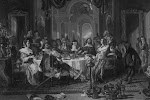
The Ancient Maya practiced certain rituals with the aid of hallucinogenic substances. Psychotropic flora and fauna used in a ritual context are termed entheogens and I wish to speak in particular about mushroom use. While deciphering the codices of the Maya is beyond my humble scholarly expertise, I believe that even a novice could make out the vaguely mushroom like apparatus wielded by the standing individual above.
This is the amanita muscaria, also known as fly agaric. The six bulbous protrusions appearing on the codex 'mushroom' have an uncanny resemblance to the white patches of the Amanita muscaria. The agaric is psychoactive and does indeed grow in the highland regions of Mesoamerica among pine forests.
Today
A. muscaria is recognized by the Quiche-Maya as
Cakuljd Ikox (lightning mushroom), hinting at it's supernatural qualities. It was termed
Xibalba ikox in the Vico dictionary, a colonial account of indigenous words, meaning 'mushroom of the underworld'. In the Dresden codex, the mushroom is associated with the Mayan glyph
cimi, the symbol for death. It becomes apparent that the mushroom has a intimate relationship with death, but the nature of that relationship is not so readily apparent.
Predominantly found in Guatemala the agaric is just one of several hallucinogenic fungi found in Central America. Ethnographic accounts reveal another fungus,
Stropharia cubensis, that enjoys usage today by at least two Maya groups: the Ch'ol and Lacandon of Southern Mexico.
S. cubensis is a dung fungus reliant on ruminant species: grass-eaters like camels, derr, bison, and sheep. In pre-Columbian Mesoamerica, deer were the only ruminant species capable of carrying and germinating the spores. With this in mind it is important to consider the deer and its nature in Maya iconography.

The deer is considered a being of the underworld and associated with hallucinations, trance-like states, and ritual performances. On this Maya vase, the central figure is a deer, performing some form of ritual amongst other anthropomorphic beasts. The figure on the left appears to be vomiting: a standard form of ritual purification. The individual on the right looks to be engaged in an enema. A fermented honey mead is thought to have been administered in this manner. That the deer is associated with these images suggests that it had some fundamental role in the ritual experience.
The mushroom, as seen in page XVIII of the Madrid Codex, held a unique niche in elite rituals. With its strong ties to death, it was a cosmic key, a device used to obtain ancestral authority for elite endeavours.
















 Both of these books were $20. The second one, "The Book of Rubies" isn't in the greatest condition, as you can see on the spine here, but the front more than makes up for it.
Both of these books were $20. The second one, "The Book of Rubies" isn't in the greatest condition, as you can see on the spine here, but the front more than makes up for it.
 I've decided to post some of my old jungle art. Taking one good look at this I can see a lot of room for improvement. What I notice most is a lack of familiarity with an actual jungle environment. Yeah...I can somehow see the moon through the trees, which all somehow look to be devoid of leaves. Of course, there are more details that need improving but you can probably pick them out. So yes, there is quite a lot this picture is lacking. It does inspire me though, the colours are sombre and the temple looks remote and mysterious, not foreboding...but somehow beckoning to be investigated. This was done by quickly sketching in black ink and painting with watercolour.
I've decided to post some of my old jungle art. Taking one good look at this I can see a lot of room for improvement. What I notice most is a lack of familiarity with an actual jungle environment. Yeah...I can somehow see the moon through the trees, which all somehow look to be devoid of leaves. Of course, there are more details that need improving but you can probably pick them out. So yes, there is quite a lot this picture is lacking. It does inspire me though, the colours are sombre and the temple looks remote and mysterious, not foreboding...but somehow beckoning to be investigated. This was done by quickly sketching in black ink and painting with watercolour.



